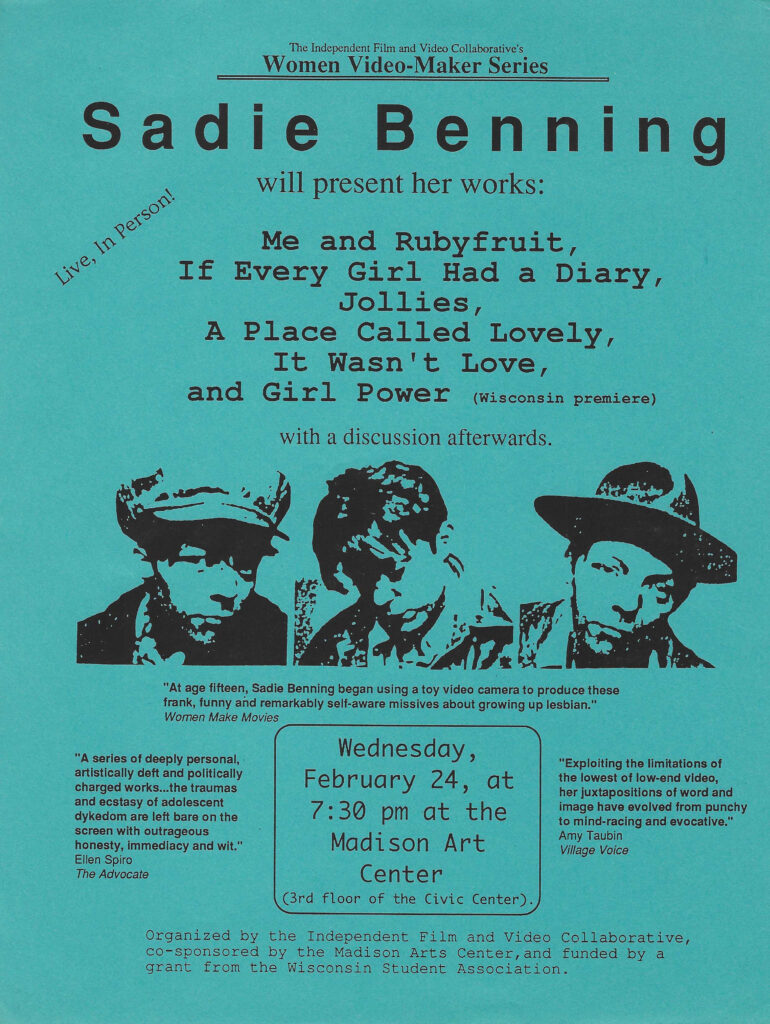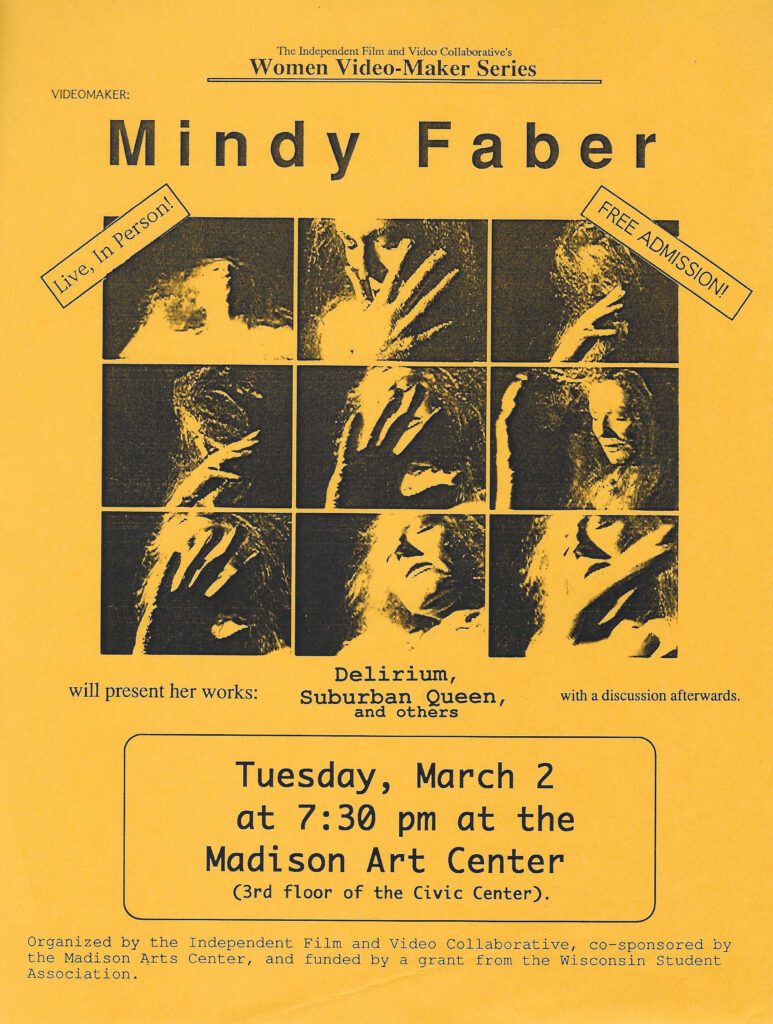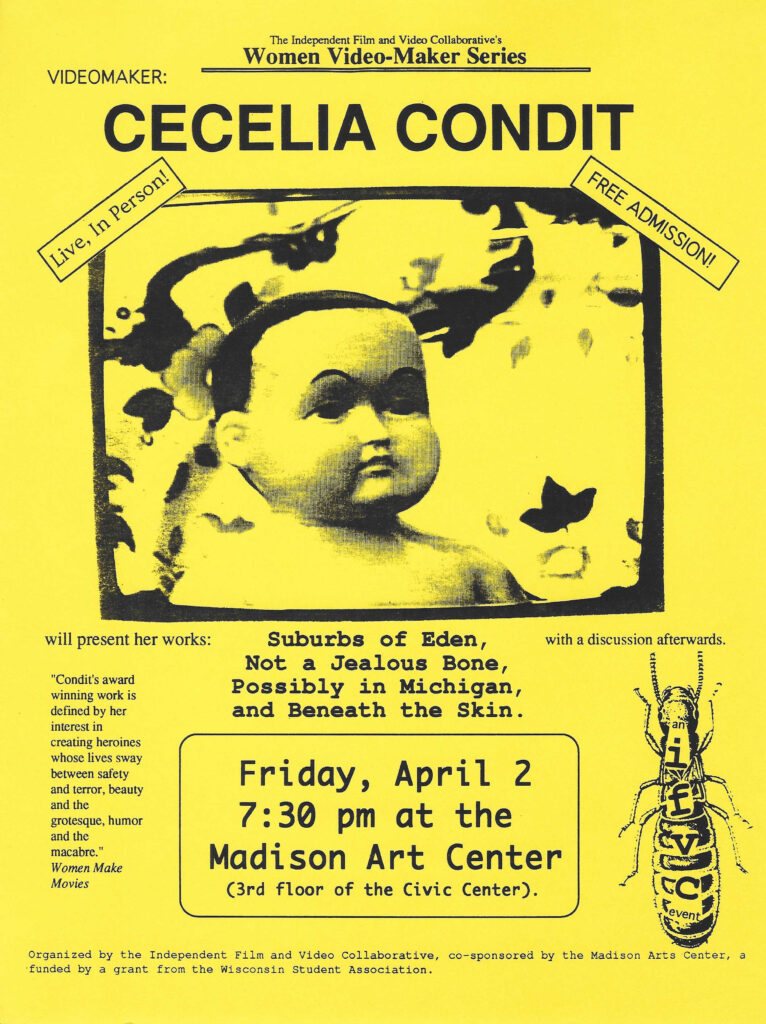UNDER CONSTRUCTION
Please read Introduction to the Documents Section

The Independent Film and Video Collaborative (IFVC) was a student organization at the UW-Madison that focused on both film production and exhibition. Its general leanings were towards experimental filmmaking, but the IFVC also organized screenings featuring independent and documentary cinema, including the occasional visiting filmmaker.
I attended my first Independent Film and Video Collaborative meeting in late 1988 or early 1989. I was but a wee freshman, and I met upperclass mentors including Erik Gunneson, Lisa Heller, Sean Hanish, and Michael Kutemeyer. As I continued with the group, I also met and worked with Debra McClutchy, Angela Richardson, D.W. Wanberg, among many others. My Madison West High School friends Jay Antani and Kent Hayward also were key members as we all got more involved in the Communication Arts department and production classes.
Termite Newsletter
The IFVC newsletter was called Termite, inspired by Manny Farber’s article “White Elephant Art vs. Termite Art.”,
The most inclusive description of [termite art] is that, termite-like, it feels its way through walls of particularization, with no sign that the artist has any object in mind other than eating away the immediate boundaries of [his/her] art, and turning those boundaries into conditions of the next achievement.
Film Culture, Winter 1962-63

The front page declared above the title, “Because the weight of the termite race to the weight of the human race is 10:1.”
In addition to previewing upcoming IFVC events, the Termite also provided information about regional resources for independent filmmaking.
And when there was not enough news to fill eight pages, members contributed creative writing and collages.
Open Film Shows / Open Video Shows
Each semester, the IFVC would organize two screenings to showcase student work: an “Open Film Show” and an “Open Video Show.” It was too difficult to switch back and forth between film and video within the same show, especially when using a 16mm double system film projector, which would keep an image track and magnetic soundtrack in sync (when the film was spliced properly, which it often wasn’t).
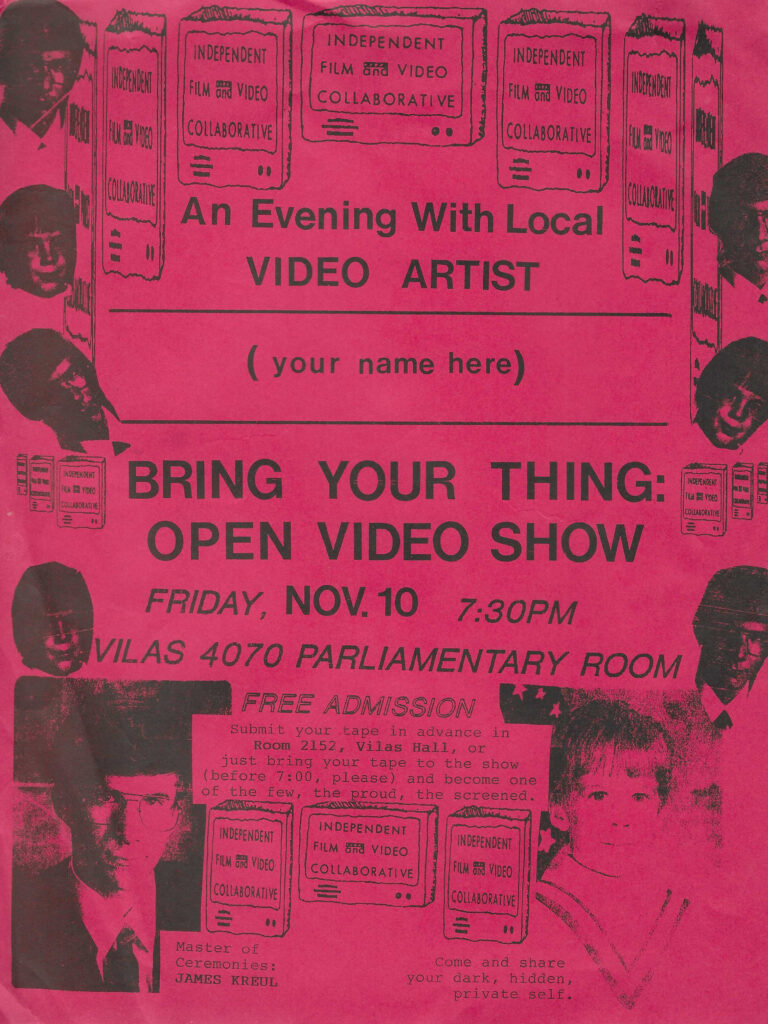
Here is one of my early contributions to the IFVC: a poster for an Open Video Show on Friday, November 10, 1989 in 4070 Vilas Hall (then commonly called the Parliamentary Room).
At the bottom left is my high school senior picture (and I graduated in 1988, so I still kind of looked like that). At the bottom right is my kindergarten school picture. The heads from each photo are then repeated in alternation along the sides.
The spirit of the screenings were not so different from current Project Projection screenings at Mills Folly Microcinema, but it was even closer to an “open mic” style show. You could literally bring a VHS tape at 7:00pm, and screen it at 7:30pm.
Summer Productions
There were several group production projects attempted over several summers. I’m going to have to do some more digging to fully document this topic.
But I could not resist posting this photo of myself (left) and Erik Gunneson (right) on the set of Glove Love. As I recall, this was a project proposal by Debra McClutchy and Ila Abramson. Ila went on to work in animation, and Debra recently received an Oscar nomination for co-directing the documentary The Martha Mitchell Effect.
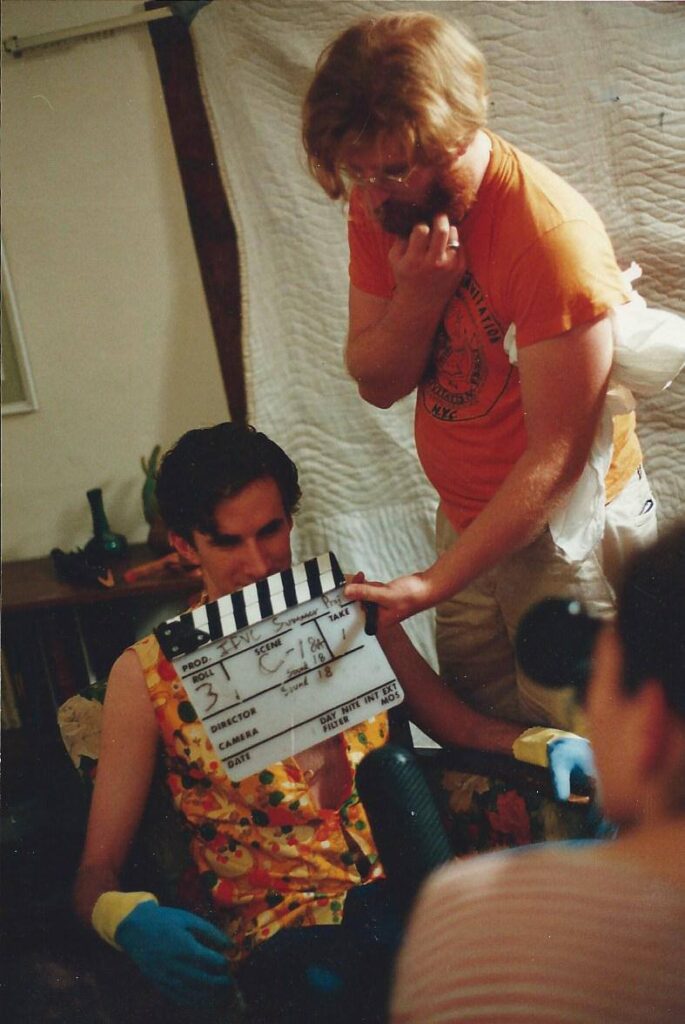
Film Programming
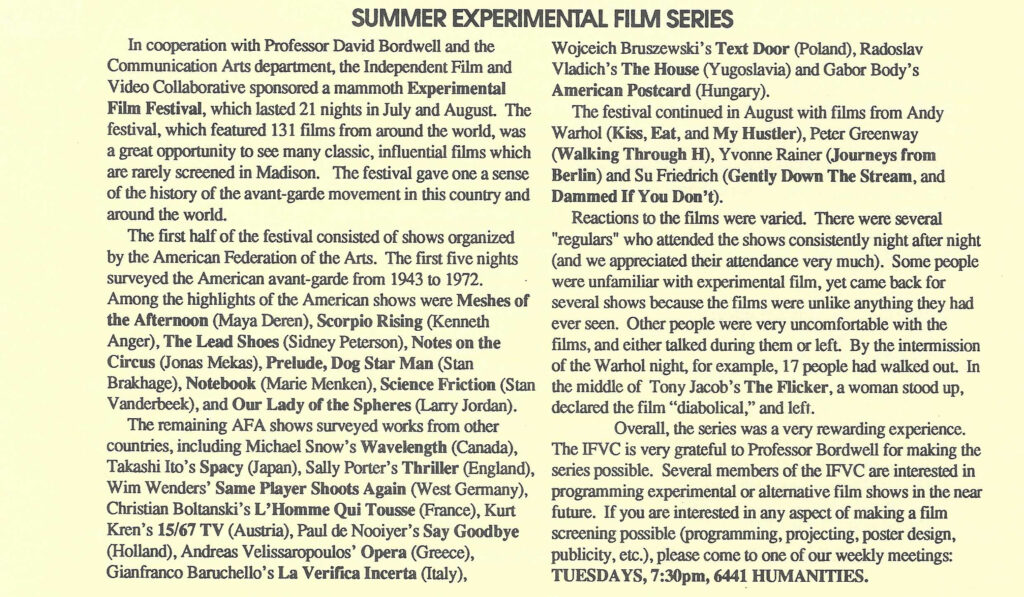
The article above appears in the Fall 1992 issue of Termite (or Le Termite, as it appears on that cover, because Kent Hayward was editor-in-chief). I had almost forgotten that this epic experimental film series happened, and it provides a great example of academic research providing an opportunity for plucky student group to make something happen. The series more than lived up to The Wisconsin Idea.
Leading into the summer of 1992, Kristin Thompson and David Bordwell were working on the first edition of their textbook, Film History (which was eventually published in 1994). Bordwell let the IFVC know that he and Thompson would be renting many 16mm prints of experimental films to prepare their section on experimental film history. Since the prints would be here (and the rental paid for already), would we be interested in screening the programs over the summer?
We said yes, and it was a massive commitment of time and effort, but well worth it.
If you want to know a compete list of films in the first five nights of the American Federation of the Arts programs, you can find a digital copy of the book-length publication A History of the American Avant-Garde Cinema: A Film Exhibition at the Internet Archive website (archive.org). And that’s not even a complete list of what was screened that summer.
One correction to the newsletter text, 30 years later. The woman who declared a film “diabolical” was responding to Tony Conrad’s The Flicker, not “Tony Jacobs.” The author probably mixed up Tony Conrad and Ken Jacobs.
That summer it had a huge impact on my continued interest in experimental film history. I can’t imagine anything close to that series happening in experimental film programming ever again in Madison.
Visiting Filmmakers
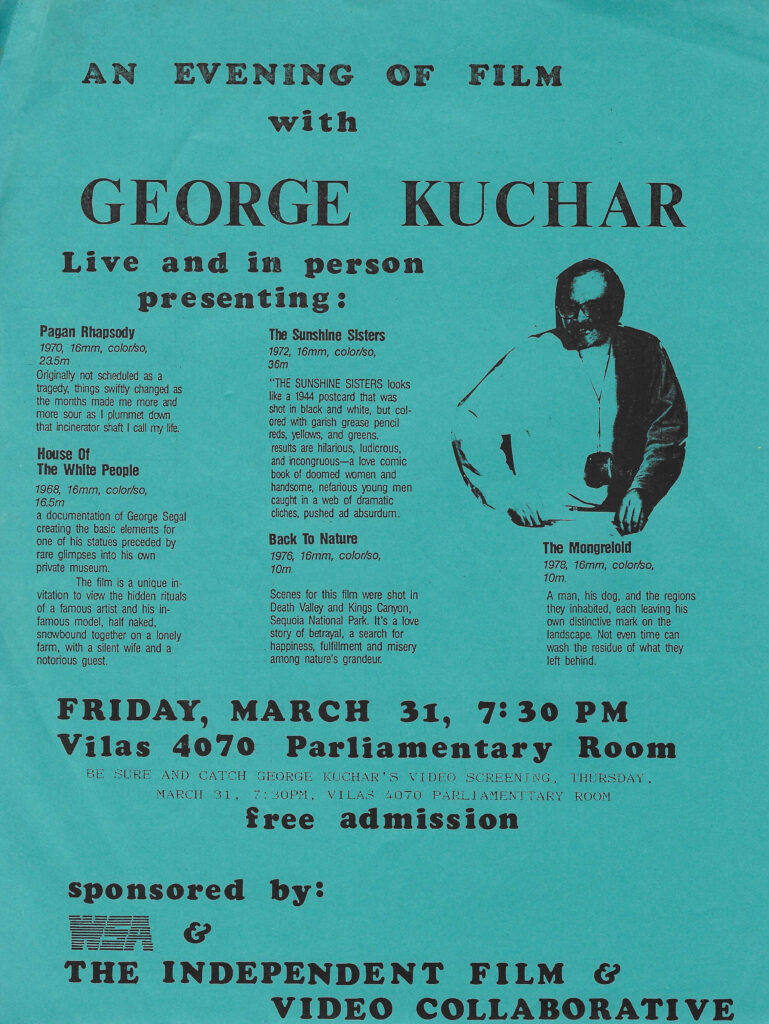
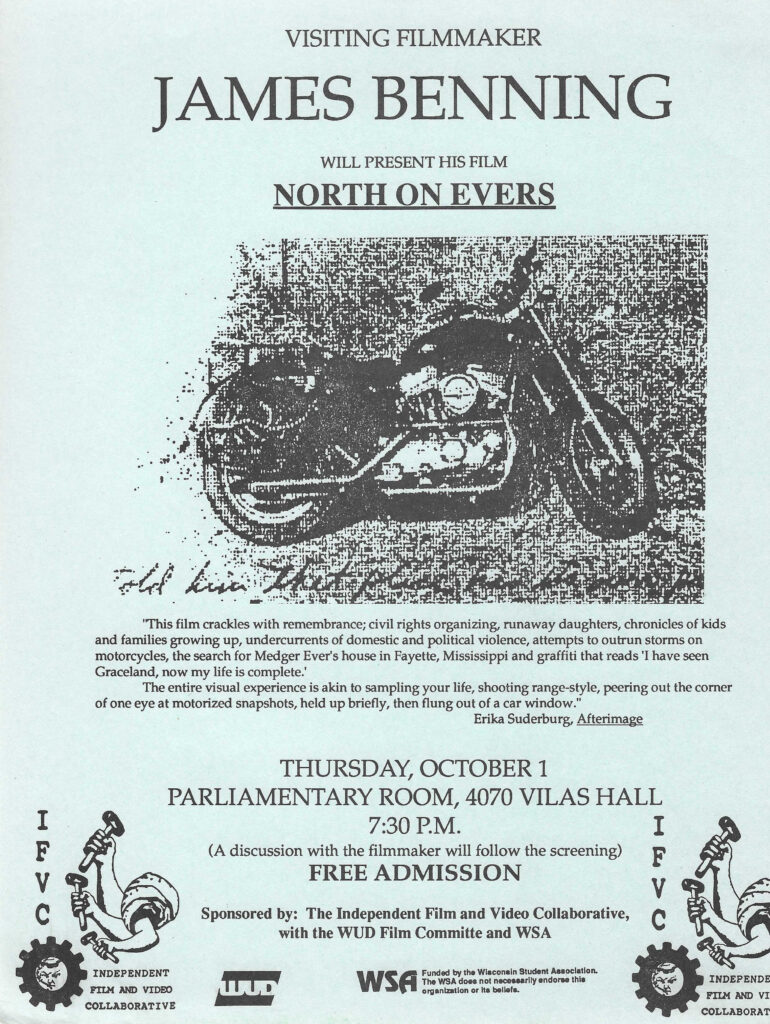
As a registered student organization, IFVC was able to apply for student government event grants to help fund screenings by visiting filmmakers. Sometimes the filmmakers were already coming to town, so we were able to add a screening for them using an event grant. The Wisconsin Student Association (WSA) was the student government preceding the Associated Students of Madison (ASM, which would be a source of funding for Madison Film Forum).
Near the end of March 1989, the Department of Art, Department of Theater and Drama, and Department of Communication Arts were already bringing in George Kuchar for a screening of his videos on Thursday, March 30 (I have that poster as well). I believe that Mike Kutemeyer took the initiative to secure a WSA grant for the Friday, March 31 screening of some of George’s 16mm films from the 1960s and 1970s.
Mike knew George because in addition to studying Communication Arts, he was also a Meteorology major. Mike appears in George’s Weather Diary 3 (1988) shot in Oklahoma’s tornado alley. George’s video diary of his Madison visit, including moments from IFVC screening in 4070 Vilas Hall, was eventually released as 500 Millibars to Ecstasy (1989).
George’s visit, and his films and videos, have had a lasting influence on me. If you’re not familiar with his work, a fine introduction to George and his brother Mike is Jennifer Kroot’s documentary, It Came from Kuchar (2009).
I was significantly involved in the Thursday, October 1, 1992 screening of North on Evers (1992) with James Benning. I designed the poster (I still lack basic graphic design skills), wrote the press release (I still have a copy) and served as the press contact (I don’t recall anyone calling me).
Born in Milwaukee, Benning received his MFA at UW-Madison in 1975 (he was David Bordwell’s teaching assistant). After the 1992 IFVC screening, I believe his next in-person screening in Madison was not until the 2004 Wisconsin Film Festival, at which he screened Four Corners (1997) as well as his California Trilogy, El Valley Centro (1999), Los (2000) and Sogobi (2001).
For a breezy introduction to Benning, take a look at Gabe Klinger’s 2013 documentary Double Play: James Benning and Richard Linklater. Or if you’re looking for something more in depth, check out Erica Balsom’s recent work on his films, like her book about Ten Skies.
There’s more to report and write about the IFVC and visiting filmmakers, and the impact those screenings had on the professional careers of IFVC members. But for now I’ll just add three more posters for another great series, this time held at the Madison Art Center in 1990. The Women Video-Maker Series would pave the way for future collaborations between the Madison Art Center and campus groups, including Madison Film Forum.
